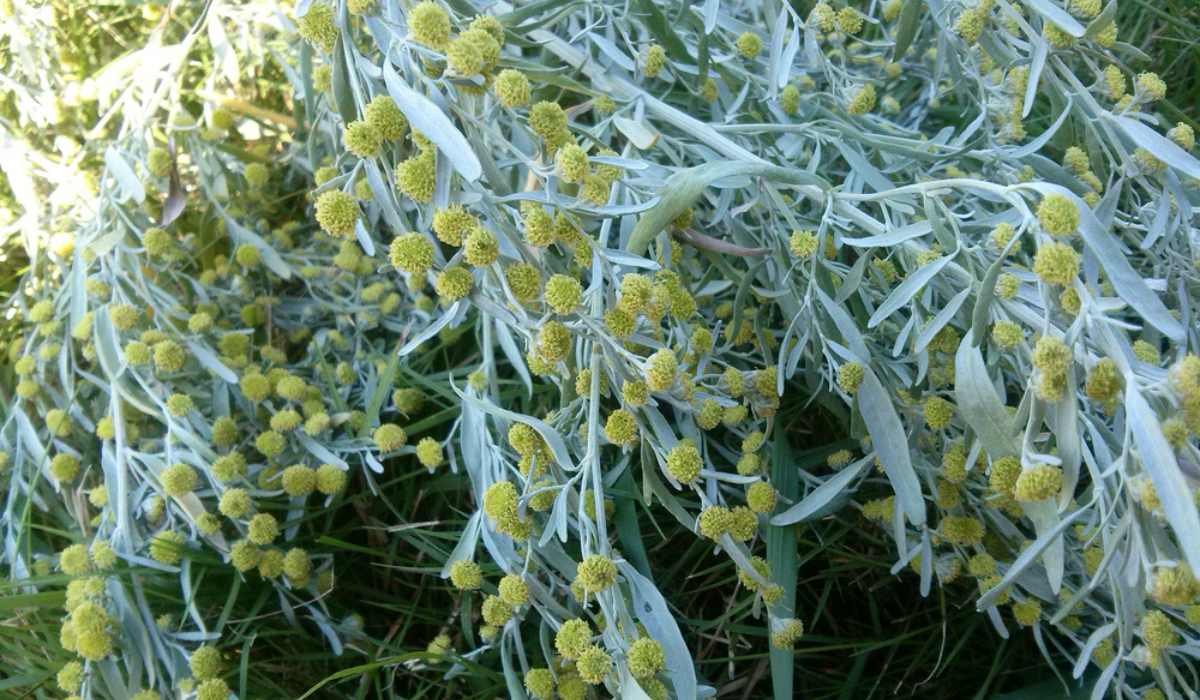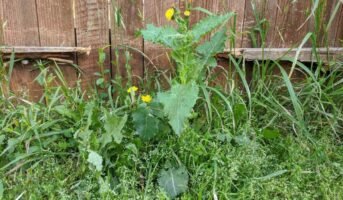What is Artemisia Absinthium?
Artemisia absinthium is a special plant that is found in abundance. The plant is also known by its common names like wormwood, grand wormwood, absinthe, absinthium, and mugwort. Artemisia absinthium is famous for being the prime ingredient of absinthe, which is an alcoholic beverage. This strong-smelling herbal plant is bitter and native to Europe, Asia, and Africa and has been naturalised in parts of America as well.
See also: Gomphrena globosa: Know more about this medicinal plant

Source: Pinterest
The plant rises only a few inches in height and is a short shrub. The soft stem sports small branches with multiple leaves that resemble the leaves of a coriander plant. The plant also blooms during autumn and produces small round clusters of flowers. It is an extremely important plant that is commercially used to produce alcohol and alcoholic beverages around the world. Additionally, it has many medicinal properties and offers cures for various illnesses.
Every part of Artemisia absinthium is toxic to humans and must not be consumed directly.
Artemisia Absinthium: Most important facts
| Artemisia absinthium | |
| Common name | Wormwood, Grand wormwood, Absinthe, Absinthium, Mugwort |
| Origin | Europe, Asia, Northern Africa |
| Type | Shrub |
| Indoor/Outdoor | Outdoor |
| Soil | Loamy, sandy, chalky |
| Temperature | 15-25°C |
| Water | Moderate |
| Sunlight | Full sun |
| Flower | Round, yellow flowers in clusters |
Artemisia absinthium: How to grow
Artemisia absinthium is a perennial plant that grows anywhere from 3 to 6 feet tall. The plant has dark green leaves and clusters of white flowers that bloom from June to September.
- The plant can be propagated by seed, cutting or division.
- To propagate Artemisia absinthium, you must take a cutting from a mature plant and place it in water for about two weeks.
- Cuttings should be kept moist but not wet.
- Once the cuttings have rooted, they can be planted in dirt or potting soil and kept indoors until the weather warms enough for them to grow outdoors.
- Artemisia absinthium can also be propagated by inserting an inch-long piece of the stem into an open container filled with soil on top of a plastic bag filled with dampened peat moss.
- Leave the stem in place for several weeks before replanting it outside in the full sun or partial shade, depending on where you live. Artemisia absinthium plant prefers full sun.
see: All about Gomphrena Globosa
Artemisia absinthium: Care tips
Artemisia absinthium is a hardy plant that is easy to care for. In the USA, it is considered one of the most invasive species of plants, so it grows fairly well without much care. It also doesn’t have a lot of requirements from the soil and survives in sandy and infertile soil as well. However, there are certain care tips that can be followed if you want to grow the plant well.

Source: Pinterest
Soil
Since Artemisia absinthium can survive on a variety of soils, you can use any mix you want. It can grow in loamy, chalky, and sandy soil alike. Additionally, it needs little to no fertilisation for growth. However, you can use organic compost to aid its growth. Make sure the soil is well drained since it cannot survive water logging at the roots.
Water
Artemisia absinthium doesn’t require lots of water for growth. It can easily survive for days without a single drop of water. However, watering them every other day will help them mature faster. Check the soil and water them when the top two inches have dried up. Additionally, avoid over-watering as it might lead to root rot.
Sunlight
Artemisia absinthium is an outdoor plant and requires plenty of sunshine for growth. Place it in your garden, where it receives more than 5 hours of sunlight every day.
Artemisia absinthium: Benefits
Artemisia absinthium is not just used to make alcoholic beverages and absinthe. It is an important medicinal herb that can immensely help cure many medical problems. The plant possesses some great qualities that help with pain management and the treatment of digestive disorders.

Source: Pinterest
Here are some of the top medicinal benefits of Artemisia absinthium:-
Helps cure Crohn’s disease
Artemisia Absinthium is now becoming popular as a treatment for Crohn’s disease. This disease affects the digestive system and causes it to get inflamed. This condition may cause several stomach problems, like acute stomach pain, diarrhoea, and tiredness. Several studies so far have shown that extracts of this plant can be extremely beneficial in reducing this inflammation and curing symptoms of Crohn’s disease.
Read also: Hyptis Suaveolens: A medicinal plant for stomach
Alleviates joint and body pain
Artemisia absinthium has anti-inflammatory properties that can be extremely beneficial in reducing pain. It can bring down infections and heal inflamed areas to reduce pain and help the body cope with the problem. Additionally, it can be extremely useful in providing relief from knee pain and joint pains that are caused by muscle inflammation.
Ejects parasites and worms
Artemisia absinthium is extremely useful in expelling parasites such as pinworms, roundworms, and tapeworms from the body. These parasites are found in the intestines and can lead to chronic digestive health problems. Extracts of wormwood have been used to make medicines to treat these parasitic infections.
Aids digestion
Artemisia absinthium is said to improve digestive health by preventing problems like gas, bloating, heartburn, stomach pain, constipation, and diarrhoea. The compounds present in the plant can help relieve symptoms of digestive disorders and maintain gut health.
Cures arthritic symptoms
The plant has a unique anti-inflammatory property that can be extremely beneficial in curing arthritis. It brings down inflammation in the knees and provides relief from pain related to arthritis. The antioxidant effects of the plant also help in protecting cells from damage and pain.
FAQs
What is Artemisia absinthium used for?
Artemisia absinthium is used to create medicines for treating illnesses like Crohn's disease, muscle pain, parasite infestation, etc. It is also commercially used to produce absinthe and other alcoholic beverages.
Is Artemisia absinthium toxic for dogs?
Artemisia absinthium is toxic to dogs and cannot be kept around pets. Dogs are attracted to this plant in spite of its toxicity, so the plant must be kept away from pets.
Housing News Desk is the news desk of leading online real estate portal, Housing.com. Housing News Desk focuses on a variety of topics such as real estate laws, taxes, current news, property trends, home loans, rentals, décor, green homes, home improvement, etc. The main objective of the news desk, is to cover the real estate sector from the perspective of providing information that is useful to the end-user.
Facebook: https://www.facebook.com/housing.com/
Twitter: https://twitter.com/Housing
Email: [email protected]











